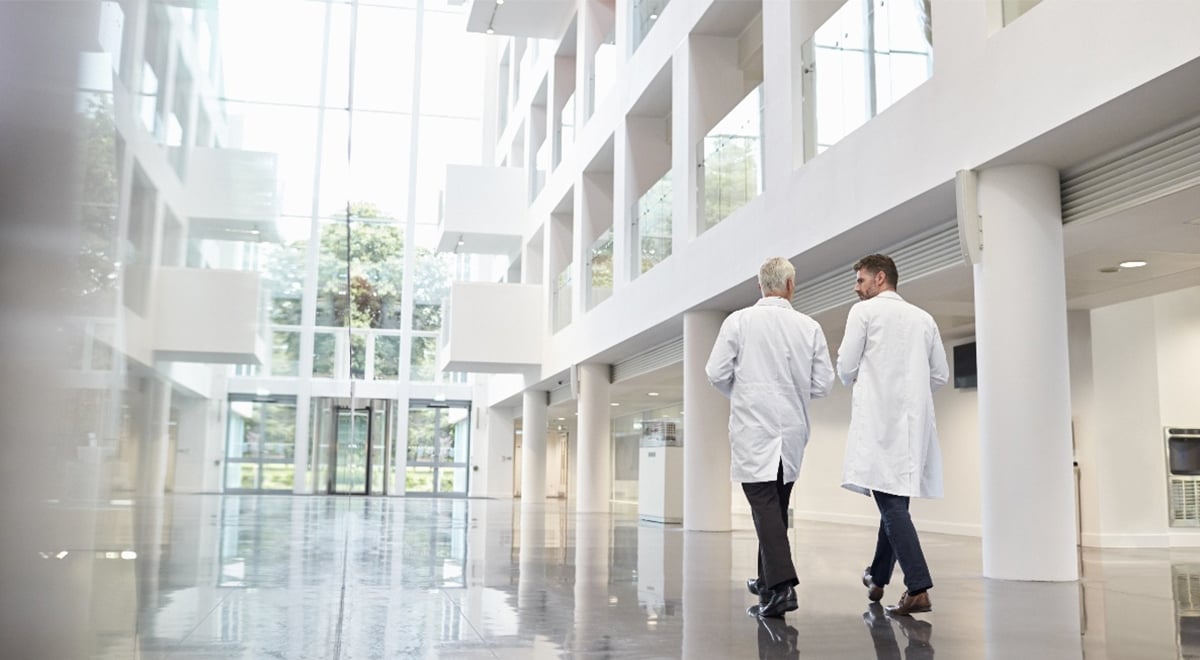It may seem unusual to link innovations in PVC with hospital interiors. PVC has long been known as a hard-wearing product, which is easy to clean. However, innovations involving antimicrobial additives have now made PVC interiors an integral part of the international public health strategy to prevent the transfer of infections.
Hospitals are high traffic areas that are in use 24 hours a day, every day of the year. Their interior surfaces are subject to round-the-clock treatment as a result. Foot traffic, trolleys, wheeled beds, and wheelchairs traverse hospital floors continuously. Walls get bumped as beds are pushed from one area to another. All surfaces, including ceilings, can be exposed to bacteria and contaminants, creating health risks for patients.
Although vinyl flooring made the initial inroads for PVC products in hospitals, PVC wall coverings and ceilings are now also extensively used.
Advantages of PVC for hospital interiors
Vinyl flooring is extremely hard wearing. It is expected that PVC in this service should have a lifespan of at least 20 years, even with heavy traffic. It has the added advantage of being shock absorbent, making it comfortable to walk on. The anti-static properties of PVC also protect people and sensitive electronic equipment from static discharges.
PVC wall coverings benefit from the material’s resistance to knocks and scratches. Concrete walls can chip and look unsightly, while PVC resists this type of wear and tear and maintains its high-quality finish.
One of the key properties of PVC that makes it ideal for hospital interior use is its ease of cleaning. Vinyl has a very smooth surface, making it easy to keep clean and sanitized. This is vital for hospitals, where the build-up of any waste can lead to serious health consequences for both patients and healthcare professionals.
Innovative uses for PVC in hospital interiors
While the basic properties of PVC make it a good match for hospital interiors, innovations in PVC are making it invaluable.
Hospitals are currently taking on the challenge of Hospital Acquired Infections (HAIs). These “super bugs” could be emerging from lack of proper disinfection, or from an increased resistance of pathogens to sterilisation procedures. However they come about, they carry a serious risk for patients. Statistics show that on any given day, about 80,000 patients contract a healthcare-associated infection in European acute care hospitals. While these range in severity, the challenge remains to improve the resistance of hospital interiors to the transfer of pathogens.
Several new innovations in PVC are helping hospitals to overcome the challenge of HAIs. Antimicrobial additives can now be bound into the PVC during manufacturing. Silver ions are the most common antimicrobial agent used. They are added to the PVC product by a dosing mechanism on the injection or extrusion machine. They can also be added as a powder to the polymer before it enters the machine.
These silver ions locate in the polymer voids of vinyl products. They prevent bacteria from propagating by limiting cell growth. PVC floor tiles, wall coverings and ceilings can all be infused with antimicrobial additives, thus contributing to the overall sterile environment of the hospital. This innovation in PVC, along with excellent cleaning and disinfection practices, can reduce the prevalence of HAIs and therefore contribute to patient health.
Antimicrobial agents are also being added to other PVC products used in hospitals like catheters, wound dressings and some textiles.
Aesthetic innovations in PVC are also improving the patient experience in hospitals. Almost any colour, pattern or shape can be included in a PVC design. This opens up a wide variety of design possibilities. Markings within the vinyl flooring can provide directions for patients. Pictures can set child patients at ease. Ceiling graphics can provide relief from the traditional white surfaces of hospitals past.
Economic benefits of PVC in hospital interiors
The European Council of Vinyl Manufacturers (ECVM) commissioned a report to investigate the total cost of ownership for PVC flooring versus other materials. Total cost of ownership was defined as the costs incurred from buying and installing the floor in the first place. It includes costs of maintenance and cleaning, as well as the cost of removal and waste disposal or recycling at the end of life. Vinyl flooring came out as the lowest total cost of ownership for light, medium and heavy traffic areas.
An impressive example of lowering lifecycle costs comes from Västra Nylands Hospital in Finland. High quality vinyl flooring saves the hospital €65,000 per year on cleaning. Over a 24-year life cycle, the facility will save €1.6 million, as well as over 58,000 litres of water, 17,000 litres of chemicals and 16,000 kWh of electricity.
Contact Vynova
Vynova is a leading European supplier of PVC with manufacturing sites in Germany, the Netherlands and France. We produce a comprehensive range of suspension PVC resins. Contact one of our PVC sales representatives or find out more about our product offers here.




